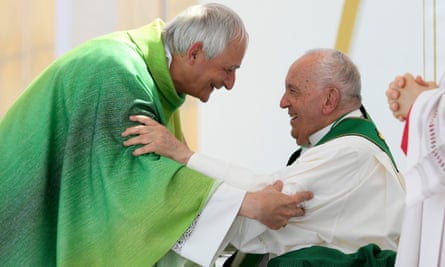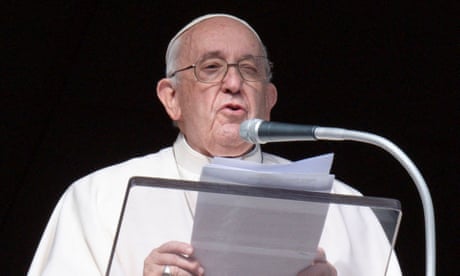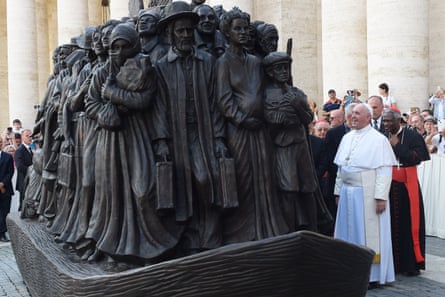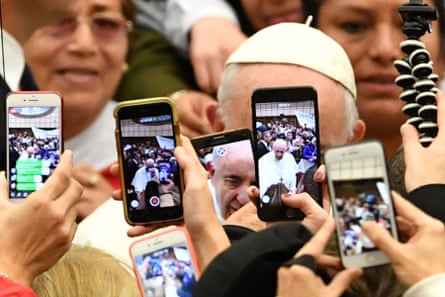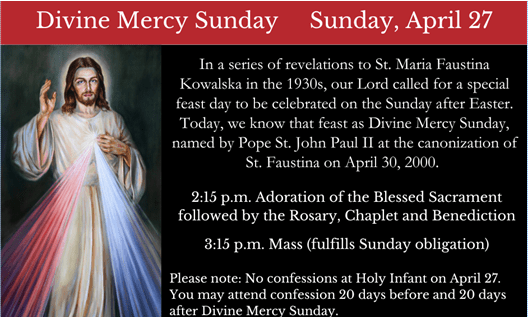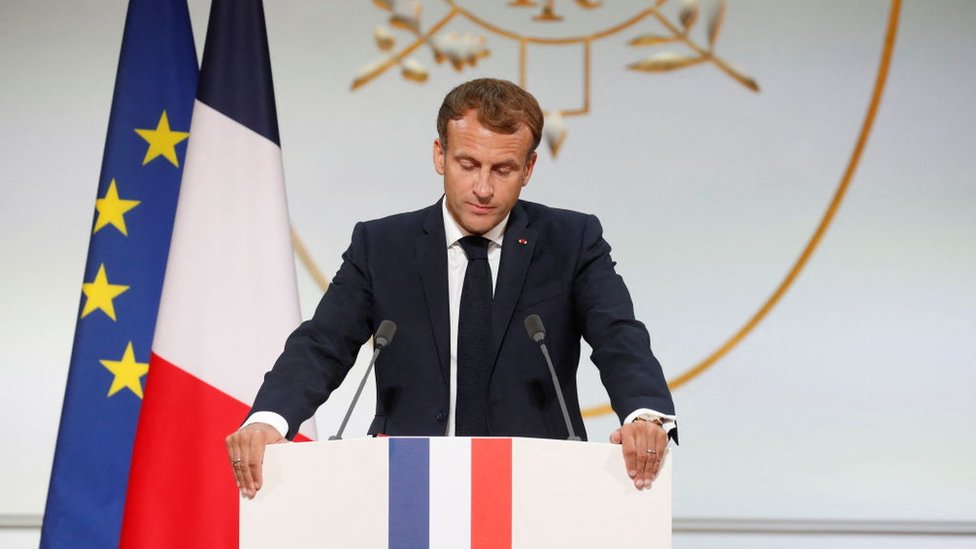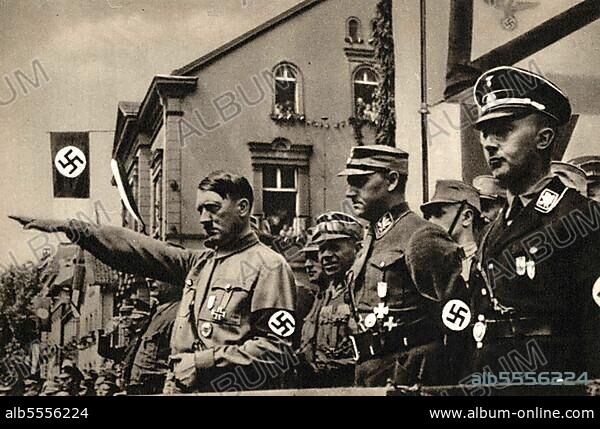|
|
General: POPE FRANCIS HAS DIED ON EASTER MONDAY AGED 88 APRIL 21 2025 ROME FUNDATION
Scegli un’altra bacheca |
|
Rispondi |
Messaggio 1 di 8 di questo argomento |
|
Pope Francis has died on Easter Monday aged 88
Pope Francis died on Easter Monday, April 21, 2025, at the age of 88 at his residence in the Vatican's Casa Santa Marta.
By Devin Watkins
At 9:45 AM, Cardinal Kevin Farrell, Camerlengo of the Holy Roman Church, announced the death of Pope Francis from the Casa Santa Marta with these words:
"Dearest brothers and sisters, with deep sorrow I must announce the death of our Holy Father Francis. At 7:35 this morning, the Bishop of Rome, Francis, returned to the house of the Father. His entire life was dedicated to the service of the Lord and of His Church. He taught us to live the values of the Gospel with fidelity, courage, and universal love, especially in favor of the poorest and most marginalized. With immense gratitude for his example as a true disciple of the Lord Jesus, we commend the soul of Pope Francis to the infinite merciful love of the One and Triune God."
The Director of the Holy See Press Office, Matteo Bruni, told journalists later on Monday that the late Pope's body could be transferred to St. Peter's Basilica on Wednesday morning, so that the faithful may pray before his mortal remains.
"The translation of the Holy Father's mortal remains to the Vatican Basilica, for the veneration of all the faithful, may take place on the morning of Wednesday, April 23, 2025, according to the arrangements that shall be determined and communicated tomorrow, following the first Congregation of the Cardinals," Mr. Bruni said.
The Pope was admitted to the Agostino Gemelli Polyclinic Hospital on Friday, February 14, 2025, after suffering from a bout of bronchitis for several days.
Pope Francis’ clinical situation gradually worsened, and his doctors diagnosed bilateral pneumonia on Tuesday, February 18.
After 38 days in hospital, the late Pope returned to his Vatican residence at the Casa Santa Marta to continue his recovery.
In 1957, in his early 20s, Jorge Mario Bergoglio underwent surgery in his native Argentina to remove a portion of his lung that had been affected by a severe respiratory infection.
As he aged, Pope Francis frequently suffered bouts of respiratory illnesses, even cancelling a planned visit to the United Arab Emirates in November 2023 due to influenza and lung inflammation.
In April 2024, the late Pope Francis approved an updated edition of the liturgical book for papal funeral rites, which will guide the funeral Mass which has yet to be announced.
The second edition of the Ordo Exsequiarum Romani Pontificis introduces several new elements, including how the Pope’s mortal remains are to be handled after death.
The ascertainment of death takes place in the chapel, rather than in the room where he died, and his body is immediately placed inside the coffin.
According to Archbishop Diego Ravelli, Master of Apostolic Ceremonies, the late Pope Francis had requested that the funeral rites be simplified and focused on expressing the faith of the Church in the Risen Body of Christ.
“The renewed rite,” said Archbishop Ravelli, “seeks to emphasise even more that the funeral of the Roman Pontiff is that of a pastor and disciple of Christ and not of a powerful person of this world.”
https://www.vaticannews.va/en/pope/news/2025-04/pope-francis-dies-on-easter-monday-aged-88.html |
|
|
 Primo
Primo
 Precedente
2 a 8 di 8
Successivo
Precedente
2 a 8 di 8
Successivo
 Ultimo
Ultimo

|
|
Rispondi |
Messaggio 2 di 8 di questo argomento |
|
Pope Francis, groundbreaking Jesuit pontiff, dies aged 88
Death of 266th head of Catholic church triggers period of global mourning and Vatican conclave of cardinals to elect successor
Mon 21 Apr 2025 15.35 BST
Pope Francis, the pontiff revered by millions of Catholics around the world whose popular appeal reached far beyond his global congregation, has died at the age of 88.
Cardinal Kevin Ferrell, the Vatican camerlengo, said: “At 7.35 this morning, the bishop of Rome, Francis, returned to the home of the Father. His entire life was dedicated to the service of the Lord and of his church.″
The official declaration of the pope’s death is expected on Monday evening, when his body will be placed in its coffin. The cause of death is also likely to be disclosed.
Francis’s body will be transferred to St Peter’s basilica on Wednesday morning to allow members of the public to pay their respects.
Cardinals will meet on Tuesday morning to decide the date of the pope’s funeral, which must take place between four and six days after death. The funeral will be followed by nine days of official mourning.
Francis, who had chronic lung disease and had part of one lung removed as a young man, was admitted to Gemelli hospital in Rome on 14 February for a respiratory crisis that developed into double pneumonia. He spent 38 days there, the longest hospitalisation of his 12-year papacy.
He was discharged from hospital on 23 March and made his last public appearance on Sunday, when he spoke briefly to the crowds gathered in St Peter’s Square for Easter mass.
Pope Francis appears on St Peter's Square for Easter Sunday mass - video
King Charles said he and the queen – who met the pope in Rome last week – had “heavy hearts” at the news of his death, adding that Francis would be remembered for his compassion and tireless commitment.
President Trump posted on social media: ““Rest in Peace Pope Francis! May God Bless him and all who loved him!” Former president Joe Biden said Francis would be “remembered as one of the most consequential leaders of our time”, and Barack Obama said he was a “rare leader who made us want to be better people”.
In Italy, Giorgia Meloni, the prime minister, said: “I had the privilege of enjoying his friendship, his advice and his teachings, which never failed even in moments of trial and suffering.”
Loved by many Catholics for his humility, Francis simplified rites for papal funerals last year and previously said he had already planned his tomb in the basilica Santa Maria Maggiore in the Esquilino neighbourhood in Rome, where he went to pray before and after trips overseas. Popes are usually buried with much fanfare in the grottoes beneath St Peter’s Basilica in Vatican City.
Amid intense mourning over the coming days and weeks, manoeuvring within the Vatican over who is to succeed Francis and become the 268th head of the Catholic church is certain to begin. Cardinals from around the world will head to Rome for a conclave, the secret, complex election ritual held in the Sistine Chapel and involving about 138 cardinals who are eligible to vote.
The conclave must begin its deliberations within 20 days of the pope’s death.
Some of the potential contenders mooted before Francis’s death were Matteo Zuppi, a progressive Italian cardinal, Pietro Parolin, who serves as the Vatican’s secretary of state, and Cardinal Luis Antonio Tagle, from the Philippines.
Francis greets cardinal Matteo Maria Zuppi during a mass for the conclusion of Catholic Social Week in Trieste, Italy, last year. Photograph: Vatican Pool/Getty Images
His death is likely to exacerbate sharp divisions within the curia, with conservatives seeking to wrest control of the church away from reformers.
During his 12-year papacy, Francis – the first Jesuit pope – was a vocal champion of the world’s poor, dispossessed and disadvantaged, and a blunt critic of corporate greed and social and economic inequality. Within the Vatican, he criticised extravagance and privilege, calling on church leaders to show humility.
His views riled significant numbers of cardinals and powerful Vatican officials, who often sought to frustrate Francis’s efforts to overhaul the ancient institutions of the church. But his compassion and humanity endeared him to millions around the world
Francis, who was born Jorge Mario Bergoglio in Buenos Aires, Argentina, in 1936, was elected pope in March 2013. He immediately signalled his style of papacy by taking the bus, rather than papal car, to his hotel, where he paid his bill before moving into the Vatican guesthouse, eschewing the opulent papal apartments. At his first media appearance, he expressed his wish for a “poor church and a church for the poor”.
Francis leading a procession at the opening of the special assembly of the synod of bishops for the pan-Amazon region in October 2019. Photograph: Andreas Solaro/AFP/Getty Images
He focused papal attention on poverty and inequality, calling unfettered capitalism the “dung of the devil”. Two years into his papacy, he issued an 180-page encyclical on the environment, demanding the world’s richest nations pay their “grave social debt” to the poor. The climate crisis represented “one of the principal challenges facing humanity in our day”, the pope said.
He called for compassion for and generosity towards refugees, saying they should not be treated as “pawns on the chessboard of humanity”. After visiting the Greek island of Lesbos, he offered 12 Syrians refuge at the Vatican. Prisoners and the victims of modern-day slavery and human trafficking were also highlighted in his frequent appeals for mercy and social action. During his recent period in hospital, he kept up his telephone calls to the Holy Family church in Gaza, a nightly routine since 9 October 2023.
A boy shakes Francis’s hand as he greets people at Moria refugee camp on the Greek island of Lesbos in April 2016. Photograph: Reuters
One of the biggest issues with which Francis had to contend was that of clerical sexual abuse and the church’s cover-up of crimes committed by priests and bishops. In the first few years of his papacy, as wave after wave of scandals engulfed the church, Francis was accused by survivors and others of failing to understand the scale of the crisis and the urgent need to proactively root out abuse and its cover-up.
In 2019, Francis summoned bishops from around the world to Rome to discuss the crisis and later issued an edict requiring priests and nuns to report sexual abuse and its cover-up to the church authorities, and guaranteeing protection for whistleblowers. It was a significant move towards the church taking responsibility for the scandals, and went much further than his predecessors.
Francis attending the unveiling of a sculpture called Angels Unaware depicting a group of 140 migrants of various cultures and from different historic times in St Peter’s Square in 2019. Photograph: Vatican Pool/Corbis/Getty Images
Also during his tenure as the head of the Catholic church, Francis was obliged to respond to repeated acts of terrorism and persecution. He was at pains to stress that violence had no part to play in true practice of religion, and that people should not conflate acts of terrorism with Islam. “I think it is not right to identity Islam with violence,” he said after the murder of a Catholic priest in France in 2016. “I think that in nearly all religions there is always a small fundamentalist group,” he said, adding: “We [Catholics] have them.”
Francis spoke with compassion on issues of sexuality (famously responding “who am I to judge?” to a question about gay priests), the family and the role of women in society – while adhering to traditional Catholic doctrine on marriage, contraception and abortion. Although many on the left strove to claim Francis as one of their own, he could not easily be defined as liberal or conservative.
On his many trips abroad, Francis was greeted like a rock star, with hundreds of thousands – sometimes millions – waiting for hours for a glimpse of the diminutive, white-robed figure in his open-sided popemobile. His appeal was particularly strong among young people, whom he frequently urged to reject materialism and overdependence on technology. “Happiness … is not an app that you can download on your phones,” Francis told Catholic youth in April 2016.
People greet Francis and take photos of him with their mobile phones as he arrives for a weekly general audience in January 2019. Photograph: Andreas Solaro/AFP/Getty Images
The deliberations and final choice of the Catholic church’s cardinal electors in the coming days and weeks will determine whether Francis’s efforts to reform its institutions and to shift its emphasis towards the poor will be a durable legacy.
https://www.theguardian.com/world/2025/apr/21/pope-francis-dies |
|
|
|
Rispondi |
Messaggio 3 di 8 di questo argomento |
|
Pope Francis died of a stroke, confirms Vatican in statement
Francis died of "cerebral stroke, coma, irreversible cardiocirculatory collapse," says Vatican in a statement.
 POPE FRANCIS MAKES A SURPRISE APPEARANCE AT THE END OF THE MASS FOR PALM SUNDAY AT ST PETER'S SQUARE IN THE VATICAN ON APRIL 13, 2025. | TIZIANA FABI / AFP
Pope Francis died of a stroke, causing a coma and "irreversible" heart failure, according to his death certificate released by the Vatican Monday.
The 88-year-old Catholic leader died on Monday morning, almost a month after having been discharged from five weeks in hospital where he nearly succumbed to double pneumonia.
Francis died at 7.35am (0535 GMT) in his apartment at the Santa Marta residence in the Vatican. He died of "cerebral stroke, coma, irreversible cardiocirculatory collapse", the death certificate said.
The pontiff had already been affected by a previous episode of acute respiratory failure when he had double pneumonia in hospital, it added.
He had also suffered from arterial hypertension, multiple bronchiectasis and Type 2 diabetes – something that was not previously known.
It was signed by the director of health of the Vatican City State, professor Andrea Arcangeli.
https://www.batimes.com.ar/news/world/pope-francis-died-of-a-stroke-confirms-vatican-in-statement.phtml |
|
|
|
Rispondi |
Messaggio 4 di 8 di questo argomento |
|
Pope Francis has died aged 88, a day after making a much hoped-for appearance at Saint Peter’s Square on Easter Sunday, the Vatican says in a statement.
HITLER S BIRTHDAY APRIL 20TH (EASTER SUNDAY 2025)
|
|
|
|
Rispondi |
Messaggio 5 di 8 di questo argomento |
|
|
|
|
Rispondi |
Messaggio 6 di 8 di questo argomento |
|
FRANCE S FLAG DA VINCI CODE
|
|
|
|
Rispondi |
Messaggio 7 di 8 di questo argomento |
|
WEDNESDAY APRIL 23=SAINT GEORGE
FRIDAY APRIL 25=SAINT MARK (VENICE) INDIANA JONES
|
|
|
|
Rispondi |
Messaggio 8 di 8 di questo argomento |
|
Adolf Hitler (* 20 April 1889 in Braunau am Inn) († 30 April 1945 Berlin), Leader of the Nazi Party, Reich Chancellor from 1933, also self-appointed "Fuehrer" and head of state of Germany.
https://www.album-online.com/detail/es/YTRkYWI0MA/adolf-hitler-april-1889-braunau-am-inn-1945-berlin-leader-alb5556224
EASTER SUNDAY
Mary Magdalene, seeing that the stone of the tomb had been rolled away, ran to tell Peter and John. After receiving the shocking news, the two disciples also went out and — as the Gospel says — “the two were running together” (Jn 20:4). The main figures of the Easter narratives all ran! On the one hand, “running” could express the concern that the Lord’s body had been taken away; but, on the other hand, the haste of Mary Magdalene, Peter and John expresses the desire, the yearning of the heart, the inner attitude of those who set out to search for Jesus. He, in fact, has risen from the dead and therefore is no longer in the tomb. We must look for him elsewhere.
This is the message of Easter: we must look for him elsewhere. Christ is risen, he is alive! He is no longer a prisoner of death, he is no longer wrapped in the shroud, and therefore we cannot confine him to a fairy tale, we cannot make him a hero of the ancient world, or think of him as a statue in a museum! On the contrary, we must look for him and this is why we cannot remain stationary. We must take action, set out to look for him: look for him in life, look for him in the faces of our brothers and sisters, look for him in everyday business, look for him everywhere except in the tomb.
We must look for him without ceasing. Because if he has risen from the dead, then he is present everywhere, he dwells among us, he hides himself and reveals himself even today in the sisters and brothers we meet along the way, in the most ordinary and unpredictable situations of our lives. He is alive and is with us always, shedding the tears of those who suffer and adding to the beauty of life through the small acts of love carried out by each of us.
For this reason, our Easter faith, which opens us to the encounter with the risen Lord and prepares us to welcome him into our lives, is anything but a complacent settling into some sort of “religious reassurance.” On the contrary, Easter spurs us to action, to run like Mary Magdalene and the disciples; it invites us to have eyes that can “see beyond,” to perceive Jesus, the one who lives, as the God who reveals himself and makes himself present even today, who speaks to us, goes before us, surprises us. Like Mary Magdalene, every day we can experience losing the Lord, but every day we can also run to look for him again, with the certainty that he will allow himself to be found and will fill us with the light of his resurrection.
Brothers and sisters, this is the greatest hope of our life: we can live this poor, fragile and wounded existence clinging to Christ, because he has conquered death, he conquers our darkness and he will conquer the shadows of the world, to make us live with him in joy, forever. This is the goal towards which we press on, as the Apostle Paul says, forgetting what lies behind and straining forward to what lies ahead (cf. Phil 3:12-14). Like Mary Magdalene, Peter and John, we hasten to meet Christ.
The Jubilee invites us to renew the gift of hope within us, to surrender our sufferings and our concerns to hope, to share it with those whom we meet along our journey and to entrust to hope the future of our lives and the destiny of the human family. And so we cannot settle for the fleeting things of this world or give in to sadness; we must run, filled with joy. Let us run towards Jesus, let us rediscover the inestimable grace of being his friends. Let us allow his Word of life and truth to shine in our life. As the great theologian Henri de Lubac said, “It should be enough to understand this: Christianity is Christ. No, truly, there is nothing else but this. In Christ we have everything” (Les responsabilités doctrinales des catholiques dans le monde d'aujourd'hui, Paris 2010, 276).
And this “everything” that is the risen Christ opens our life to hope. He is alive, he still wants to renew our life today. To him, conqueror of sin and death, we want to say:
“Lord, on this feast day we ask you for this gift: that we too may be made new, so as to experience this eternal newness. Cleanse us, O God, from the sad dust of habit, tiredness and indifference; give us the joy of waking every morning with wonder, with eyes ready to see the new colours of this morning, unique and unlike any other. […] Everything is new, Lord, and nothing is the same, nothing is old” (A. Zarri, Quasi una preghiera).
Sisters, brothers, in the wonder of the Easter faith, carrying in our hearts every expectation of peace and liberation, we can say: with You, O Lord, everything is new. With you, everything begins again.
https://www.vatican.va/content/francesco/en/homilies/2025/documents/20250420-omelia-pasqua.html |
|
|
 Primer Primer  Anterior 2 a 10 de 10 Siguiente Anterior 2 a 10 de 10 Siguiente  Último Último  |
|
|
|
 Primo
Primo
 Precedente
2 a 8 de 8
Successivo
Precedente
2 a 8 de 8
Successivo
 Ultimo
Ultimo

|
|
| |
|
|
©2025 - Gabitos - Tutti i diritti riservati | |
|
|


